German Weapons &
Equipment
for Operation Sealion (Seelöwe)
German weapons that were available for Operation Sealion were basically
those that had been
available for the Invasion of France (Fall Gelb). These are so well
documented that there is no need to cover them here. What I will
describe is those special weapons that were designed for amphibious
operations as well as any new weapons that arrived after the invasion
of France started but which might have been available in time
for Seelöwe.
After the collapse of the allied armies in France,
the Wehrmacht started planning for the invasion of
Great Britain. It was thought was that no
amphibious landing would succeed without tank that
could support the beach assault, so
a number of amphibious
and submersible conversions were tried. Tests were carried out with
the Pz Kpfw II and
38(t) as amphibious tanks and the Pz Kpfw III and IV
as submersible
tanks.
An experimental tank company was formed on 13th July 1940 and
by the end of the month four tank batallions were formed. These were
named Tauch-Panzer-Abteilung A through D. These batallions were
organised according to K.St.N.1107b and K.St.N.1171b dated 16th July
1940 and consisted of:
Battalion HQ (stab):
- 1 Tauchpanzer III
- 2 Tauchpanzerbefehlswagen III
Three light panzer companies, each containing:
- Company HQ: 2 Tauchpanzer III
- Light Tank Detachement: 4 Schwimmpanzer II
- 1st Platoon: 5 Tauchpanzer III
- 2nd Platoon: 5 Tauchpanzer III
- 3rd Platoon: 4 Tauchpanzer IV
Of the four tank battalions, two would form the 18th Panzer Regiment and the other two the 28th Panzer Regiment.
During the first hours of Operation Barbarossa, these regiments were used to cross the Bug river.
Tauchpanzer (Submersible Tank)
Conversion to submersible tanks was done to both Pz Kpfw III
and Pz Kpfw IV tanks.
168 Panzer III (ausf F, G, H and several commander Pz.Bf.Wg. ausf E) and 42 Panzer IV (ausf D) were converted to the submersible version.
The submersible
tanks had all the external openings sealed with a waterproof
compound and the space between the turret and
the hull was made tight using an inflatable rubber loop.
Rubber caps covered the commander's cupola, the
gun mantlet
and the hull machine-gun of hull. These could be removed from
inside using an electric detonator. The driver's visor was
made watertight using a special metal cover with a vision block.
Air was provided to the engine by a
flexible 18m long 20cm diameter "snorchel" pipe with an attached buoy, which held it on the surface of the water, allowing
a maximum operating depth of 15m. The buoy also mounted the wireless
antenna. The exhaust fumes exited the tank through by a large
vertical pipe with a non-return valve.
To pump out water that could enter the tank, an additional evacuation pump was installed. The crew members had individual breathing aids borrowed from the submariners.
The tank could operate under water for 20 minutes and had a
maximum submerged speed of 6km/h.
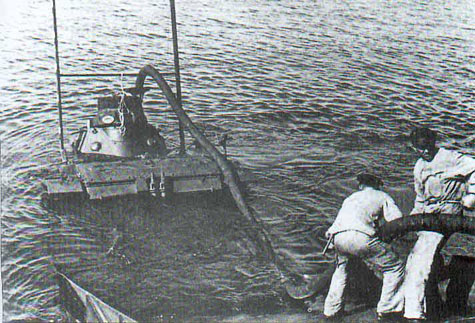
Tauchpanzer III being launched from its parent vessel.
Tactics were developed to launch the tank from its parent vessel at a
suitable distance from the shore using either a hinged ramp or a crane. A gyro-compass
was fitted for submerged navigation. Additionally, radio instructions
from the parent vessel would be used to help the tanks navigate to the
shore.
Tauchpanzer III
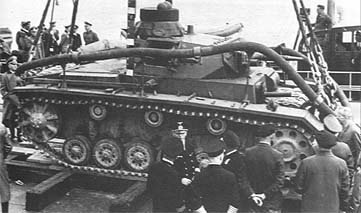
Between July and October 1940, 168 Pz Kpfw III tanks
were
converted to Tauchpanzer III. Of the 160 were fighting tanks
of Ausf F, G and H. The other
8 tanks were Panzerbefehlswagen Ausf. E command tanks. At least some of
these tanks were armed with the 5cm KwK 38 L/42 gun which had not been
issued in time to see service in France, but could have made a
noticeable difference when faced by British armour.
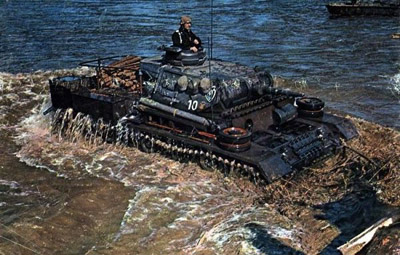
A Panzerbefehlswagen - note the antenna on the rear deck.
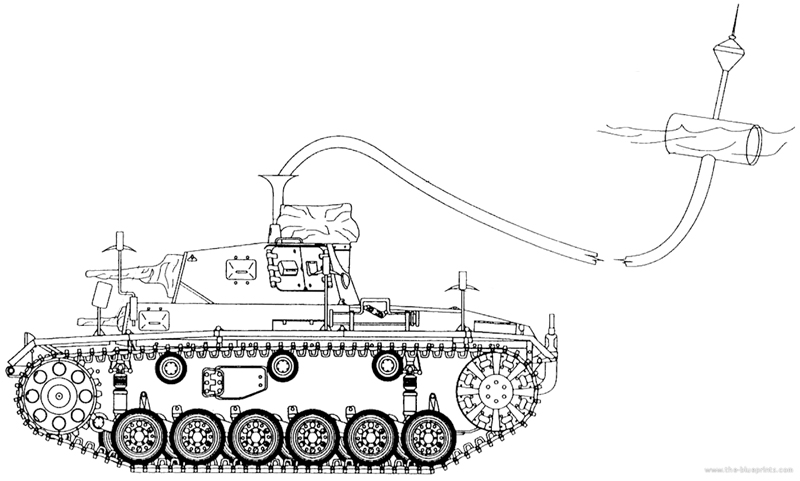
Tauchpanzer IV
Starting in July 1940, 48 Panzer IV Ausf D tanks were
converted to Tauchpanzer IV.
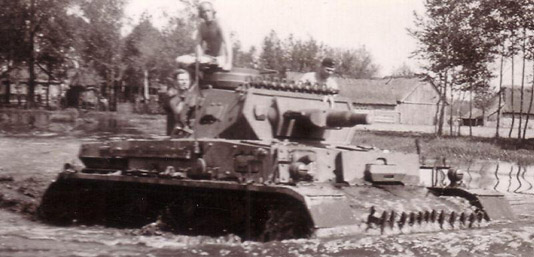
Schwimmpanzer II
The Schwimmpanzer II or
Panzerkampfwagen II mit Schwimmkörper was a conversion of
the Pz Kpfw II with floatation tanks which
permitted travel on the water surface. It was planned
that
they would
swim ashore from their parent vessel lying offshore.
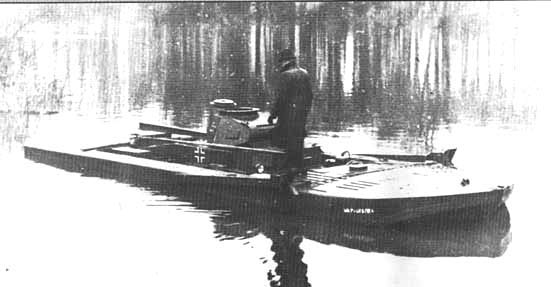
The flotation tanks were attached
on extensions to the track return rollers, with propulsion being
provided by
a propeller taking power from the drive sprocket. The inside
of the tank was divided into three watertight compartments. It had a
top speed of 10 km/h afloat.
One advantage possessed by the
Schwimmpanzer over Tauchpanzer versions was that it
could use its guns
during the landing.
It was even planned for some schwimmpanzers
to
retain their floats after the
landing
to facilitate crossing of the Royal Military Canal;
a 28 mile canal stretching from Hythe to Cliffend in East
Sussex.
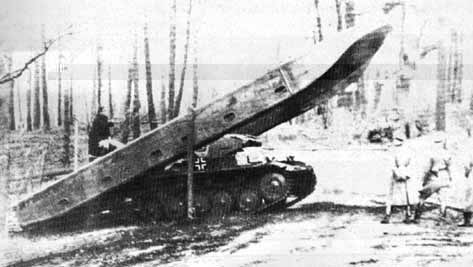
Schwimmpanzer 38(t)
Tests were also carried out to add floatation
tanks to
the Pz Kpfw 38(t) to convert it to an amphibious tank. It does not
appear that any large numbers were so converted.
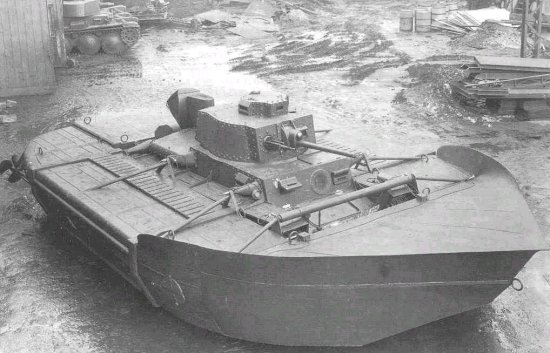
The Panzergranate 40 was an Armour Piercing Composite Rigid
shot with a sub-calibre
tungsten core and a mild steel body with a plastic or alloy ballistic
cap. The shot is of a lighter weight than the normal shot of
the same calibre and thus has a higher muzzle
velocity. However because the shot is lighter but still has the same
overall size it has poorer ballistic qualities, and loses velocity and
accuracy and penetration at longer ranges.
The only Pzgr.40 shot produced in time for the French campaign
were 3,7cm for the 3,7cm L/45 KwK36 tank gun or the 3,7cm PaK 35/36
anti-tank gun. Reports by OKW show that
7,440 3,7cm Pzgr.40 rounds were fired out of a total of about 70,000
(i.e.
approx 10%).
The 4,7cm PaK(t) on the Panzerjäger I received
the Pzgr.40 in July 1940, the 2cm Pzgr.40 was not introduced
until
later in the year. Both of these could have been available
for Operation
Sealion. Other Pzgr.40 shot, such as the 3,7cm KwK(t) and 5 cm KwK,
were not introduced until May 1941; too late for the Invasion of
Britain.
It is not unreasonable to assume that the Tauschpanzer III and
Schwimmpanzer II leading the beach assault would have been provided
with a good proportion of Pzgr.40 shot.
A comparison between the performance of the Pzgr.40
(APCR) is shown below.
| MG 34 |
SmK |
785 |
8 |
3 |
|
|
|
| SmKH |
785 |
13 |
8 |
|
|
|
| Panzerbüchse 39 |
SmKH |
1265 |
34 |
14 |
|
|
|
| 2 cm KwK 30 & 38 |
Pzgr |
780 |
20 |
14 |
9 |
|
|
| Pzgr.40 |
1050 |
49 |
20 |
|
|
|
3,7 cm KwK 36
3,7 cm PaK 35/36 |
Pzgr |
745 |
35 |
29 |
22 |
20 |
|
| Pzgr.40 |
1020 |
64 |
31 |
|
|
|
| 3,7 cm KwK 38
(t) |
Pzgr.(t) |
741 |
36 |
31 |
25 |
22 |
|
| 4.7 cm PaK(t) |
Pzgr.36(t) |
775 |
54 |
48 |
41 |
35 |
|
| Pzgr.40 |
1080 |
100 |
59 |
|
|
|
| 5 cm KwK 38 |
Pzgr.39 |
685 |
54 |
46 |
36 |
28 |
22 |
| 7,5 cm KwK 40 |
K Gr rot Pz |
385 |
41 |
38 |
35 |
32 |
30 |
| Gr38 H1/A |
450 |
70 |
70 |
70 |
70 |
|
| 8,8 cm FlaK 18 & 37 |
Pzgr.39 |
773 |
120 |
110 |
100 |
91 |
84 |
| 








